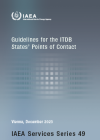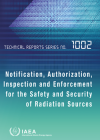Protecting people and the environment from any risks of radiation requires a legislative framework and a national regulatory infrastructure for the control of radiation sources. The IAEA’s Safety Standards, Code of Conduct and guidance documents provide the international requirements and recommendations for such a regulatory system.
Radiation sources
Ensuring radiation safety in the use of radiation sources and the operation of related facilities needs a cradle-to-grave system that includes the relevant legislation, regulations and guidance; an operational and independent regulatory body with sufficient resources and suitably qualified and experienced staff; and the implementation of regulatory control activities, such as notification, authorization, inspection and enforcement.
The IAEA’s Safety Standards, the Code of Conduct on Safety and Security of Radioactive Sources and the Guidance on the Import and Export of Radioactive Sources lay out the international requirements and recommendations for an appropriate and sustainable regulatory system for the control of sources.
Providing tools for regulatory bodies
The IAEA promotes a number of dedicated tools to assist regulatory bodies in strengthening the effectiveness of their functions and processes:
- The Self-Assessment of Regulatory Infrastructure for Safety (SARIS), a methodology and set of tools to facilitate the States' regular own compliance review with the IAEA Safety Standards;
- The Regulatory Authority Information System (RAIS), a software application developed by the Agency to assist its Member States in managing their regulatory activities in accordance with IAEA Safety Standards and guidance;
- The Control of Sources Network (CSN), a platform designed for radiation safety regulators, providing them with an instrument to strengthen the sharing of knowledge and experience in how to establish and maintain a functional, effective and efficient system for the regulatory control of radiation sources; and
- The Radiation Safety Advisory Mission Tool (RASAMT), a web platform hosted on a password-protected platform that supports the performance of advisory missions for the regulatory control of radiation sources.
- The IAEA-developed Systematic Assessment of Regulatory Competence Needs (SARCoN) methodology and software tool support Member States’ work to ensure regulatory competence in line with the IAEA safety standards.
- The IAEA-developed Toolkit, a collaboration web platform, and e-learning course on the control of radioactive material inadvertently incorporated into scrap metal.
Aside from these tools for nuclear regulators, the IAEA also offers a variety of services to Member States, such as the Integrated Regulatory Review Service (IRRS), reviews of radiation safety regulations, and the advisory mission on the regulatory infrastructure for radiation safety.








